Reception

Native American elders have held traditional dedication ceremonies for a number of Army helicopters, including the UH-72 Lakota in 2012. [1]
This is a list of U.S. military equipment named after Native American peoples, places, weapons or material culture.
The U.S. Army and "Indians" could fairly be described as traditional enemies of one another in the 19th century; among other things there was a long series of conflicts known as the Indian Wars. [1] In the 20th and 21st centuries Indigenous peoples played a significant role in U.S. military operations; for example the code talkers of World Wars I and II, and Ira Hayes, one of the soldiers who raised the flag on Iwo Jima, was Akimel O'odham (Pima) born and raised in Gila River Indian Community. [2]
U.S. Army General Hamilton H. Howze, put in charge of naming helicopters in 1947, disliked the existing insect names "Hoverfly" and "Dragonfly" (the official name for the R-4 and planned name for the H-5), and decided the H-13 should be named for the Sioux. [3] This was a tradition for years and was codified into army regulation in 1969 with AR 70-28: "Army aircraft were specifically categorized as requiring 'Indian terms and names of American Indian tribes and chiefs.' Names to choose from were provided by the Bureau of Indian Affairs." [2] According to one military analyst arguing that U.S. military equipment names should be more evocative than an opaque series of names and numbers wrote, "The 1969 regulation codifying the tradition directed that name selection should appeal to the imagination, respect dignity, suggest aggressive spirit and confidence in the platform, and reflect its tactical characteristics. Such criteria should be applied more broadly." [4] The tradition continued after AR 70-28 was repealed prior to the designation of the Eurocopter UH-72 Lakota, but wasn't regulated to do so.
The only exception to AR 70-28 was for the Bell AH-1 Cobra, a dedicated attack helicopter.

Native American elders have held traditional dedication ceremonies for a number of Army helicopters, including the UH-72 Lakota in 2012. [1]
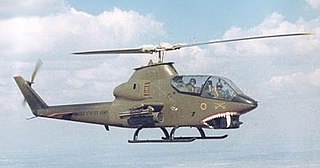
The Bell AH-1 Cobra is a single-engined attack helicopter developed and manufactured by the American rotorcraft manufacturer Bell Helicopter. A member of the prolific Huey family, the AH-1 is also referred to as the HueyCobra or Snake.

The Sikorsky UH-60 Black Hawk is a four-blade, twin-engine, medium-lift utility military helicopter manufactured by Sikorsky Aircraft. Sikorsky submitted the S-70 design for the United States Army's Utility Tactical Transport Aircraft System (UTTAS) competition in 1972. The Army designated the prototype as the YUH-60A and selected the Black Hawk as the winner of the program in 1976, after a fly-off competition with the Boeing Vertol YUH-61.

The Bell UH-1 Iroquois is a utility military helicopter designed and produced by the American aerospace company Bell Helicopter. It is the first member of the prolific Huey family, as well as the first turbine-powered helicopter in service with the United States military.

The Hughes OH-6 Cayuse is a single-engine light helicopter designed and produced by the American aerospace company Hughes Helicopters. Its formal name is derived from the Cayuse people, while its "Loach" nickname comes from the acronym for the Light Observation Helicopter (LOH) program under which it was procured.
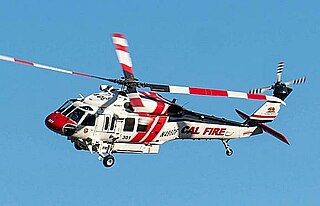
The Sikorsky S-70 is an American medium transport/utility helicopter family manufactured by Sikorsky Aircraft. It was developed for the United States Army in the 1970s, winning a competition to be designated the UH-60 Black Hawk and spawning a large family in U.S. military service. New and improved versions of the UH-60 have been developed since. Civilian versions, and some military versions, are produced under various S-70 model designations.

The Boeing MH-6M Little Bird and its attack variant, the AH-6, are light helicopters used for special operations in the United States Army. Originally based on a modified OH-6A, it was later based on the MD 500E, with a single five-bladed main rotor. The newest version, the MH-6M, is based on the MD 530F and has a single, six-bladed main rotor and four-bladed tail rotor.

The United States military has developed a number of Helicopter Armament Subsystems since the early 1960s. These systems are used for offensive and defensive purposes and make use of a wide variety of weapon types including, but not limited to machine guns, grenade launchers, autocannon, and rockets. Various systems are still in use, though many have become obsolete.

Marine Light Attack Helicopter Squadron 367 (HMLA-367) is a United States Marine Corps helicopter squadron consisting of AH-1Z Viper attack helicopters and UH-1Y Venom utility helicopters. Originally commissioned during World War II, the squadron participated in combat operations on Peleliu and Okinawa. Reactivated during the Vietnam War, the squadron has served during numerous conflicts since. The squadron is based at Marine Corps Air Station Camp Pendleton, California and falls under the command of Marine Aircraft Group 39 (MAG-39) and the 3rd Marine Aircraft Wing.
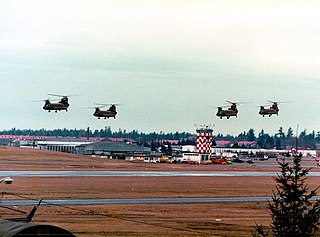
Gray Army Airfield, also known as Gray AAF, is a military airfield located within Joint Base Lewis–McChord near Tacoma, in Pierce County, Washington, United States.

The EurocopterUH-72 Lakota is a twin-engine helicopter with a single, four-bladed main rotor. The UH-72 is a militarized version of the Eurocopter EC145, built by American Eurocopter, a division of Airbus Group, Inc.
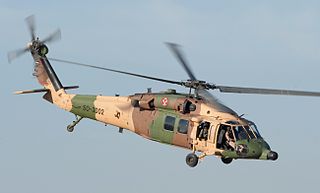
A military helicopter is a helicopter that is either specifically built or converted for use by military forces. A military helicopter's mission is a function of its design or conversion. The most common use of military helicopters is transport of troops, but transport helicopters can be modified or converted to perform other missions such as combat search and rescue (CSAR), medical evacuation (MEDEVAC), airborne command post, or even armed with weapons for attacking ground targets. Specialized military helicopters are intended to conduct specific missions. Examples of specialized military helicopters are attack helicopters, observation helicopters and anti-submarine warfare (ASW) helicopters.
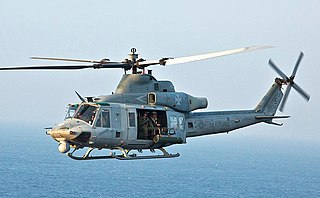
The Bell UH-1Y Venom is a twin-engine, medium-sized utility helicopter built by Bell Helicopter under the H-1 upgrade program of the United States Marine Corps. One of the latest members of the numerous Huey family, the UH-1Y is also called "Yankee" after the NATO phonetic alphabet pronunciation of its variant letter. Bell was originally to produce UH-1Ys by rebuilding UH-1Ns, but ultimately built them from scratch instead. In 2008, the UH-1Y entered service with the Marine Corps and also began full-rate production. The aircraft replaced the USMC's UH-1N Twin Huey light utility helicopters, introduced in the early 1970s. The final UH-1Y was delivered in 2018.

The McDonnell Douglas Helicopter Systems MD 500 Defender is a light multi-role military helicopter based on the MD 500 light utility helicopter and OH-6 Cayuse Light Observation Helicopter.

An armed helicopter is a military helicopter equipped with aircraft ordnance. Most commonly, it is used for attacking targets on the ground. Such a helicopter could be either purposely designed for a ground-attack mission—in which case it would be more specifically categorized as an attack helicopter—or may have been previously designed for other uses, such as utility, air cargo, aerial reconnaissance, etc., with the weapons mounts being modifications, rather than part of the design of the helicopter. The purpose of the modification to an armed helicopter configuration can be field expediency during combat, the lack of military funding to develop or purchase attack helicopters, or the need to maintain the helicopter for missions that do not require the weapons.

The Bell UH-1 Iroquois military helicopter, first introduced in 1959, is the first production member of the prolific Huey family of helicopters, and was itself developed in over twenty variants, which are listed below.

The United States Army Aviation Museum is an aviation museum located on Fort Novosel near Daleville, Alabama. It has the largest collection of helicopters held by a museum in the world. The museum features some 50 aircraft on public display with aviation artifacts ranging from a replica of the Wright brothers' Model B military biplane to an AH-64 Apache from Operation Desert Storm. The museum has over 160 aircraft in its collection and holds 3,000 historical items.

The Bell Huey family of helicopters includes a wide range of civil and military aircraft produced since 1956 by Bell Helicopter. This H-1 family of aircraft includes the utility UH-1 Iroquois and the derivative AH-1 Cobra attack helicopter series and ranges from the XH-40 prototype, first flown in October 1956 to the 21st-century UH-1Y Venom and AH-1Z Viper.
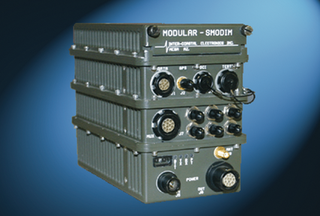
The Smart Onboard Data Interface Module (SMODIM) is an integrated device once used by the United States Army and foreign militaries for live simulated weapons training on military platforms. The SMODIM was the primary component of the Longbow Apache Tactical Engagement Simulation System that provides weapons systems training and collective Force-on-Force live training participation.